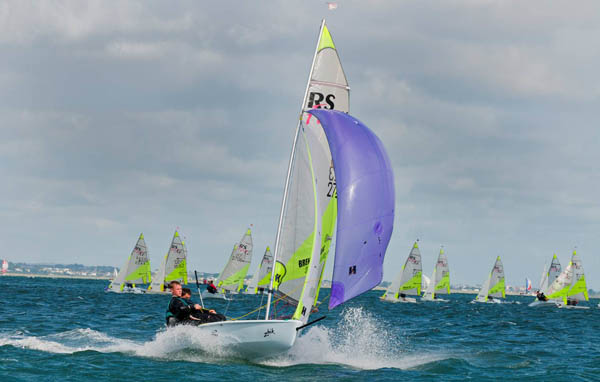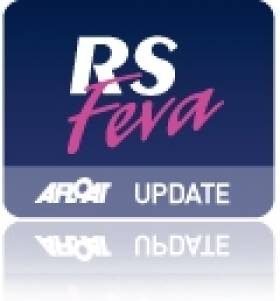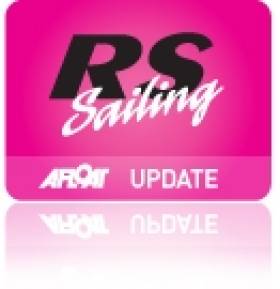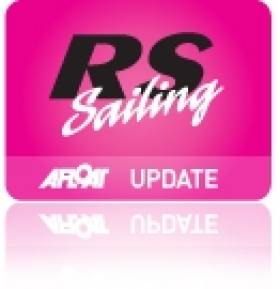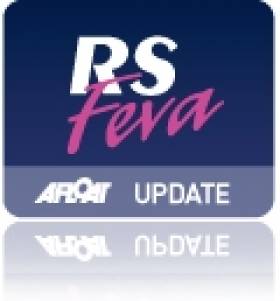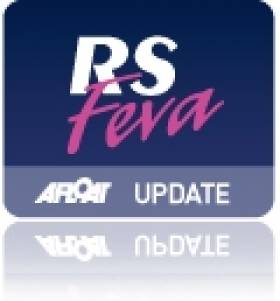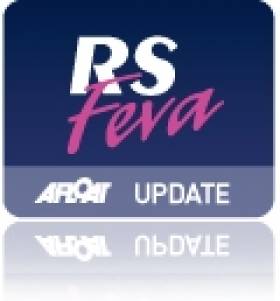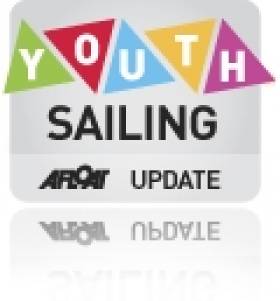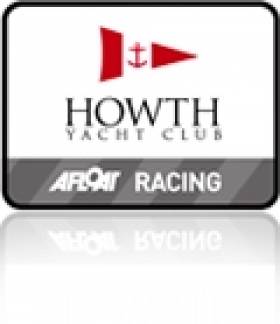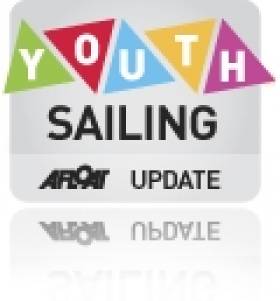Displaying items by tag: RS Feva
Places Filling Fast for 2013 RS Feva Worlds
#RSFeva - Entries for the 2013 RS Feva Worlds in Tuscany broke the 100 mark on Friday 1 February, as Yachts and Yachting reports.
More than five months remain till the start of the event at Marina di Grosetto, which runs from 19-26 July - but with just 180 places in total, the rush is surely on for Feva sailors to stake their claim.
So far 14 countries across three continents will be represented, with newcomers including the Czech Republic, Lithuania and Switzerland, while Los Angeles will also send a boat for the first time.
Full details of the event including entry forms and the Notice of Race are available vis the RS Feva Worlds website. The entry deadline is 30 June 2013 but with more than half the available spots booked already, there's no time to waste.
Here's hoping Ireland will be as well represented as we were in 2010, when 34 Irish Feva sailors took part in the Worlds at Carnac in France.
Success for Royal St George Teams at Irish RS Nationals
#RS SAILING - Howth Yacht Club hosted 54 boats in three classes for the RS400, RS200 and RS Feva National Championships over the weekend (click HERE for photos).
The Irish version of the 'RS Games' proved a big hit with all competitors. The race management team, headed by PRO David Lovegrove, did a fantastic job to get 10 races in for all three classes in spite of some shifty conditions.
This was all the more impressive as each course change required the moving of up to 10 marks. No mean feat, but the Howth Yacht Club team took it in their stride.
In the RS400 class, bothers Emmet and James Ryan from the Royal St George Yacht Club took the top spot. They didn’t make things easy by using up a discard on the first race of the event and only snatched the win on the last run of the last race having rounded the final weather mark in fourth place.
Greystones class stalwarts Simon Herriott and Tom Moran took second place, while in third place, and the top youth RS400 team, was a very impressive display by Andy Verso and Oisin Baugh, also from Greystones.
In the RS200 class it was another family affair and another Royal St George win with father-and-son pair Sean and Stephen Craig taking first place. It was extremely tight at the top of the 200 fleet with only three points separating the top four boats in the end.
Teams from Greystones filled the next two podium places with Frank and Kevin O’Rourke taking second and last year’s champions Roy Van Maanen and Glen Reid taking third place.
In the Feva class, GB sailors filled the top three slots with Elliott Wells and Jake Todd taking the title on count back from fellow Hayling Island sailors Tom Darling and Will Dolin. Chay and Stirling Taylor took third place.
In the battle for local/Irish bragging rights, Eoin Lyden and Brian Stokes from Cork got one over the Dublin rivals to claim top Irish Feva spot.
Full results can be found at the Howth Yacht Club website at www.hyc.ie, while photos of the event are available HERE.
RS200/400 Demo at Royal St George Next Weekend
#RS SAILING - UK RS Association chairman Pete Vincent will be running another RS200 and 400 demo day from the Royal St George Yacht Club on the weekend of 24-25 March.
The well-known expert on RS boats is being brought to Dublin by RS400 owners Richard Tate and Emmet Ryan, who are "really keen to get an RS fleet up and running" in Dun Laoghaire.
"After the huge attention our boats have drawn both ashore and on the water, we feel there is already a keen interest from a broad cross section of sailors to learn something more about these incredible hiking dinghies," says Tate.
"There is a ready-to-race format for both RS200s and 400s to have a full season of racing every Tuesday and Thursday in Dublin Bay right from the go."
The RS200 is described as a "natural progression" from the RS Feva, while the RS400 "takes the concept one step further and way beyond". Both classes provide high performance assymmetrical racing for all age groups.
If you are thinking about moving into an RS200 or 400, this is the perfect opportunity to help you make your decision.
All demo sails must be booked in advance by contacting Pete Vincent directly at +44 7812 899 043 or [email protected].
RS Feva Nationals Start in Cork Harbour Tomorrow
Good winds are expected, particularly on Friday and Sunday so exciting racing conditions are predicted!
Launching is at 12.00hrs on Friday with First Gun at 13.00hrs
First Gun is at 11.00hrs Saturday & Sunday
Successful Debut for the RS100 and RS Feva in Italy
The debut event in Italy was created with the aim of being spectacular for the sailors and yet simple to follow by spectators. The event launched new courses, new scoring systems and new race rankings, all designed to thrill not only practitioners, but also all lovers of sailing. The RS100 and the RS Feva were selected for the Championship due to their suitability for the action packed courses requiring fast and manoeuvrable boats.
The crew Matteo Pilati and Mattia Duchi won in the Junior Class after an exciting final race against Andrea Dall'Ora-Gianluca Virgenti, who last week won the Italian RS Feva Championship. The final was raced on a one against one basis, over a parallel slalom course, the result of which determined the overall winner. "Sailing downwind in the fleet race was a lot of fun" said Matteo Pilati at the helm of the RS Feva. Crew Mattia Duchi added, "It was so exciting racing the parallel slalom."
In the RS100 fleet Karlo Hmeljak from Slovenia won the regatta. "I'm very happy to take part in such an innovative event" he said. "I think the new course and scoring systems are a good solution to help promote sailing. I have never seen so many people watching."
Marcelo Saguier from Argentina took second place, while Paul Childs from the UK finished third. The sailors competing in the Senior Class found the new format to be successful. "I think it was thrilling for the spectators who could watch boats tacking and gybing from a very short distance. I hope other similar races will be organized in the future", commented the Italian Luca Bursic who raced against Paul Childs for the third and fourth place.
The Eurosaf Freestyle Championships in RS100 and RS Feva was organized by Eurosaf, the Yacht Club Acquafresca at Brenzone and by FIV (Italian Sailing Federation), sponsored by Marine Pool, with the support of RS Sailing and Boattech, the Italian dealer of RS boats in Italy.
Summing up the event, Eurosaf President, Marco Predieri, said "We're always planning to create new innovative sailing ideas for competitors, yet that are attractive to spectators. An encouraging number of sailors from different countries, at both senior and junior levels took part into the first Eurosaf Freestyle Championship. It will be a starting point for other new events in the, especially to attract and involve young people into the sport."
The RS Feva Leinster Championships taking place at Howth Yacht Club were postponed today following gusts of over 40-knots in the race area. Today's sailing schedule was initially postponed before the championship was scrubbed at lunch time. The hope is to rerun the event later in the Summer.
Two races were completed on Saturday in 12 knots of wind in Howth sound.Louise Flynn Byrne and David Johnston started where they left off at the Mitsubishi Youth Nationals earlier this month and lead the 15 boat fleet ahead of Conor Totterdell and Stephen Craig of the RStGYC.
An error in rounding the windward mark ensured that Conor and Stephen won the first race, HYC's Claude Mollard and Jennie Harris were second and HYC's Nickie Delamer and Conor Howard came third.
With gusts of over 24 knots the race offer took the decision to shorten the course and allowed the sailors to return ashore. Race 2 was won by Louise and David, with Claude and Jenny in 2nd place and Conor Totterdell and Stephen Craig in 3rd.
Johnston and Byrne are RS Feva Champions
| Rank | M/F | CLASS | SAIL NO | HELM | CREW | CLUB |
|---|---|---|---|---|---|---|
| 1st | M | RS Feva XL | 2261 | David Johnston | Louise Flynn Byrne | Howth YC |
| 2nd | M | RS Feva XL | 1604 | Conor Totterdell | Stephen Craig | National YC/ Royal St George YC |
| 3rd | M | RS Feva XL | 2256 | Claude Mollard | Jenny Harris | Howth YC |
| 4th | M | RS Feva XL | 1299 | Hugh Maguire | Conor Maguire | Royal Irish YC |
| 5th | F | RS Feva XL | 3661 | Blathnaid O'Connell | Rosanna Cassidy | Royal St George YC |
| 6th | M | RS Feva XL | 2964 | Harry Johnson | James Hickey | Royal Irish YC |
| 7th | M | RS Feva XL | 2707 | Jamie Tingle | Criofan Guilfoyle | Royal Cork YC |
| 8th | M | RS Feva XL | 2691 | Aaron Jones | Conor Clery | Greystones SC |
| 9th | F | RS Feva XL | 3666 | Ciara Byrne | Megan Hayes | Greystones SC |
| 10th | M | RS Feva XL | 1648 | Andrew Fogarty | Ben Arrowsmith | Royal St George YC |
| 11th | M | RS Feva XL | 2506 | Nicholas Delamer | Conor Howard | Howth YC |
| 12th | F | RS Feva XL | 1593 | Meg Tyrrell | Maeve Rafferty | Royal Irish YC/Royal St George YC |
| 13th | M | RS Feva XL | 1655 | Eoin Cambay | Philippe Mulvey | Royal St George YC |
Howth Yacht Club Lays Out 2011 Sailing Programme
At a launch reception in the club on Thursday 31st March attended by representatives of local commerce, tourism and community bodies, HYC Commodore Roger Cagney announced that in addition to junior and adult sail training courses and club racing four days a week in the summer months, the Club would host over 20 open events during the year.
"We are used to sailing being a year-round activity," he said, "but even by our standards this will be an exceptionally busy year for Howth Yacht Club. We are fortunate in the number of talented volunteers we can call upon to help make these events successful and we have an enviable track record in this regard. We are also extremely grateful for the sponsorship of individual events from commercial concerns, details of which will be released in due course."
The major event on the 2011 calendar is undoubtedly the European Championship of the J24 Class, the world's most popular racing keelboat, when over 200 sailors from six or more countries will compete in the four-day regatta in September.
Howth will also host the Irish Championships of four classes – Puppeteer, Squib, Howth 17 and Optimist – between July 1st and late-August, with the latter attracting up to 200 competitors, together with their families, coaches and supporters. In addition, HYC will run the SB3 Eastern Championships (end April), the RS Feva Leinsters (late May) and the Dublin Match Racing Open (in J80s in early September).
The club's programme also comprises the Spring Warmer series in April, the annual Lambay Races on June 11th, the Dinghy Regatta a week later and the ever-popular Autumn League over five weekends in September/October.
Wicklow Boatyard at the Cutting Edge
Afloat magazine profiles Noonan Boats, one of the country’s leading repair facilities
From collision damage, keel fairing right up to osmosis treatments and re-sprays, Noonan boatyard in Newcastle, Greystones Co. Wicklow offers such a comprehensive service on the East Coast there is little need for any boat to go abroad for repairs these days, regardless of the extent of damage.
And news of the quality work has been spreading with boats from the four coasts Ireland coming to Wicklow for a range of work.
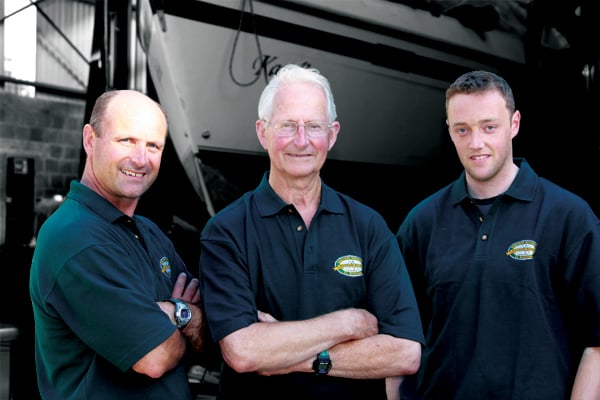
Graeme Noonan (left) has extensive big boat repair experience from his time in the marine industry in Sydney, Australia and is an active RS sailor. Founder Tony Noonan (centre) has spent a lifetime in the Irish Marine industry with Neil Watson Yachts, Wicklow Marine Services before setting up Noonan Boats in 1995. Brian Flahive is an active dinghy and keelboat sailor this year finished second in the Round Ireland double-handed class and won the Fireball National Championships.
Father and son team Tony and Graeme Noonan have over 30 years in the business and have recently expanded the premises to over 3,000 sq feet to cater for a growing range of repair work for boats up to 50 feet under cover.
They have a well-established reputation for the treatment of osmosis, to resolve hull blistering. This is a preventative and remedial process that requires specialist treatment.
The bulk of repair work comes from along the East Coast based boats and the nearby port of Dun Laoghaire but the company offers a national service to include transport to and from the Noonan boatyard if required.
“We have an established track record dealing with Insurance companies. No job is too difficult, too small or too big for us” says Tony Noonan.
Most work is carried out in in a purpose-built marine workshop containing two lifting bay facilities that includes keel and rudder repair pits but the firm also carries out on site repairs to suit too.
Repairs are carried out to original specifications and they carry out re-moulding repairs to up to date construction methods e.g. GRP foam core, Balsa core and carbon under vacuum bagging conditions.
A particular speciality is the repair of carbon repairs to dinghy masts, spinnaker poles and hulls. This has become more popular recently with the advent of carbon bowsprits on boats such as the J109s and SB3s.
Keel fairing, the process of improving the accuracy of the shape of a keel to improve boat speed is also high on the jobs list.
The company also has the specialist hot weld equipment to carry out the repair of polyethylene materials as used in the RS Feva and Laser Pico dinghies.
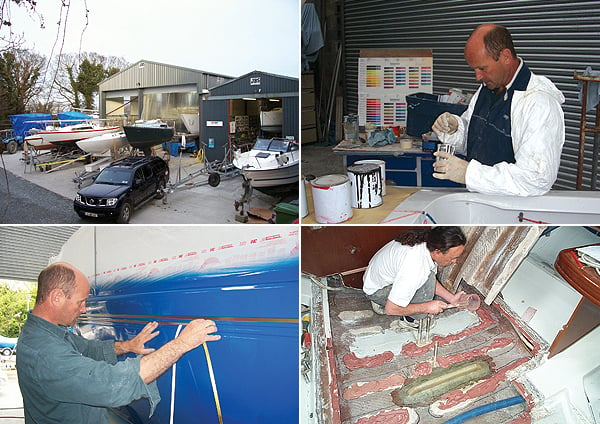
Colour Matching
Making a fibreglass repair to bring a boat back to original specification is one thing but matching gel coat to weathered or faded paintwork is quite another. Noonan Boatyard cosmetically match gels to present colour so the repair can appear practically invisible.
Polyethelene Repair
Plastic boats are durable but they can split and crack. Repairing them requires specialist heat gun welding equipment
Repair and re-spray
Weathered topsides, especially darker colours, always benefit from a re-spray, tired areas including decks and non-skid areas can also be re-sprayed
Floor matrix repair
After a keel grounding with rocks, for example, damage to a floor matrix may not be immediately visible but it is vital that inner frames are checked and repaired
Osmosis treatment, hot vac and copper coat
The yard uses the latest technology in the treatment of osmosis. Hulls are gel-planed to expose lay up prior to a HOT- VAC process and drying. This can be the stage where copper coat is an economical choice. It ends the need for the expensive and unpleasant annual chore of cleaning and repainting a boat’s hull. Simply hose down the hull at regular intervals, commonly once a year, to remove any build-up of sea-slime. We currently have two examples in our yard at present which show after one year and after ten years of immersion – and still working. Come and see for yourself!
Fully Repaired, Tried and Tested
Noonan Boats completed extensive repairs to Oystercatcher, a Gibsea 37, and when this work was completed the firm entered the boat in the gruelling 704-mile race round Ireland.
Local sailors Brian Flahive (Fireball National Champion) who works at the yard and Bryan Byrne manned what was Wicklow Sailing Club’s first ever yacht to entry into the doubled handed class of the Race. Dubbed the ‘Pride of Newcastle’ the entry finished an impressive winner of IRC III and Cruiser Class IV. The pair also finished second in the two handed class.
It was no easy journey but certainly the repairs stood up to the job, a case of repair work being tried, tested and proven!
The Boatyard, Sea Road, Newcastle, Greystones, Co. Wicklow
Tel/Fax: 01 281 9175 • Mobile: 086 170 8875
Email: [email protected]
- boats
- Wicklow
- RS Feva
- Dun Laoghaire
- Greystones
- collision
- Brian Flahive
- noonans boats
- wicklow boatyard
- boat repair
- keel fairing
- osmosis
- Newcastle
- Neil Watson
- Graeme Noonan
- Tony Noonan
- repair
- hull blistering
- Insurance
- lifting bay
- workshop
- GRP
- vacuum bagging
- carbon repairs
- dinghy masts
- spinnaker poles
- Laser Pico
- Polyethelene Repair
- respray
- Floor matrix
- hot vac
- copper coat
- Repaired
- damage
Record Attendance at the 2010 RS Feva Nationals
Conditions were varied over the weekend. Friday was a mixture of moderate and light airs but Saturday brought fresh north-westerly winds which tested the fleet and organisers. Sunday's sailing had ultimately to be abandoned. However, by that time a championship series had been completed and competitors enjoyed a sun-drenched forecourt where dancing and swimming replaced racing for the day.
The winners of the National Championships and Open Competition were Brendan Lyden and Marc Cudmore from RCYC followed by Vikki Cudmore and Amy Harrington also from Cork. Two of the UK visitors , Robert and Emma Loveridge from Draycote Water SC and Morgan Peach and Herbie Harford from Royal Torbay YC took third and fourth respectively . Two more RCYC boats, Richard Roberts and Eoin Lyden , and Dermot Lyden and Peter Stokes finished fifth and sixth.
The reigning World Champions, Owen Bowerman and Charlie Darling finished tenth, while the top finishing host club boat, Amelia O'Keeffe and Annabel Elliott, from RSGYC, came twelfth.
Seventeen Irish boats, which all also competed in the 140-boat Feva Worlds in France in July, were present at the Nationals this weekend. They were joined by other fleets from around the country; the RCYC, Greystones, Cove, Howth, NYC, RIYC, Lough Ree and Rush.
Thank you to all volunteers and staff of the Royal St George Yacht Club who worked tirelessly over the three days, especially Jack Roy, the most experienced of the International Race Officers based in Dun Laoghaire, who ensured racing - when weather permitted - went without a hitch.
